A GIS Approach for Ancient Numismatics: Spatial Analysis of Antoniniani in Sicily (3rd Century AD)
Abstract
1. Introduction
2. Case Study: The Antoniniani Period
3. Materials and Methods
3.1. Data Research and Engineering
- Two spatial fields containing the geographic location of the coins. Unfortunately, in many cases detailed coordinates, which would be desirable for GIS-applications, are not available. In fact, there are cases where only very vague information is available and the record refers to the cadastral municipality as find spot, or we should refer to the toponym location.
- The identification number.
- The findspot.
- The toponym.
- The actual Sicilian province.
- The accuracy, in order to indicate whether the coordinates identified are accurate or, as indicated above, refer to a wider area.
- The find type distinguished between survey, archaeological research or stratigraphic context, coin hoard, gift to a museum, private collection or seizure).
- The number of coins. This information is especially important in case of treasures with some coins of the same authority, mint and type.
- The portraits on the Obverse;
- The Reverse type (and if possible, reverse legend);
- The mint;
- The issue; in this field for “barbarous radiates” we have utilized the term “irregular mint”;
- The specific chronology (mint date).
3.2. Kernel Density Estimation (KDE)
4. Results
5. Discussion and Conclusions
Author Contributions
Funding
Data Availability Statement
Acknowledgments
Conflicts of Interest
Abbreviations
| GIS | Geographical Information System |
| KDE | Kernel Density Estimation |
Appendix A
- Ampolo, C.; Carandini, A.; Pucci, G.; Pensabene, P. La villa del Casale a Piazza Armerina. Problemi, saggi stratigrafici ed altre ricerche. Mélanges de l’Ecole française de Rome 1971, 83, 141–281.
- Buttrey, T.; Erim, K.; Groves, T.; Holloway, R.R. Morgantina Studies 2. The Coins (Princeton, NJ 1989) 1989.
- Carbé, A. Catalogo. In Un percorso archeologico attraverso gli scavi, Bacci, G.M.T., G., Ed.; Messina, 2001; pp. 96–97.
- Carbé, A. Considerazioni sulla circolazione monetale a Messina alla luce dei materiali degli scavi recenti. In Da Zancle a Messina. Un percorso archeologico attraverso gli scavi, Bacci, G., Tigano G, Ed.; Messina, 2002; Volume II, pp. 71–85.
- Carbé, A. Le monete. In Apollonia. Indagini archeologiche sul Monte di San Fratello 2003–2005, Bonanno, C., Ed.; Roma, 2008; pp. 63–73.
- Carbé, A. Brevi note sui rinvenimenti monetali dalla necropoli tardoantica di Halaesa. In Alaisa-Halaesa. Scavi e ricerche (1970–2007), Scibona G, T.G., Ed.; Messina, 2009; pp. 191–199.
- Carettoni, G. Tusa (Messina). Scavi di Halaesa (seconda relazione). Notizie degli Scavi di Antichità 1961, 15, 266–321.
- Castellana, G. Ricerche nel territorio agrigentino. Kokalos 1988, 34–35, 503–540.
- Chowaniec, R.; Więcek, T.; Guzzardi, L. “ Akrai” greca e” Acrae” romana. I rinvenimenti monetali degli scavi polacco-italiani 2011–2012. Annali (Istituto Italiano di Numismatica) 2013, 59, 237–269.
- Cultrera, G. Siracusa. Scoperte nel Giardino Spagna. Notizie degli scavi di antichità 1943, 33–126.
- Daehn, H.-S. Die Gebäude an der Westseite der Agora von Iaitas; E. Rentsch: 1991; Volume 3.
- Di Stefano, G. Scavi e ricerche a Camarina e nel Ragusano (1988–1992). Kokalos 1993, 39–40, 1367–1421.
- Fiorentini, G. La basilica e il complesso cimiteriale paleocristiano e proto bizantino presso Eraclea Minoa. In Proceedings of the Atti del I congresso internazionale di archeologia della Sicilia bizantina (Palermo)[Byzantino-Sicula IV], Corleone, 28 July–2 august, 2002; pp. 223–241.
- Gandolfo, L. Intervento. Kokalos 1987, XXXIII, 284–285.
- Gandolfo, L. Note sulla circolazione monetaria soluntina. In Proceedings of the Quarte giornate internazionali di studi sull’area elima. Atti, Erice, 1–4 December 2000, 2003; pp. 549–555.
- Garraffo, S. Su alcuni rinvenimenti monetari nell’area cimiteriale della ex Vigna Cassia a Siracusa. Rivista di Archeologia Cristiana Roma 1981, 283–324.
- Gentili, G.V. Siracusa: scoperte nelle due nuove arterie stradali, la Via di Circonvallazione, ora Viale P. Orsi, e la Via Archeologica, ora Viale FS Cavallari; Accademia Nazionale dei Lincei: 1951; Volume V.
- Gentili, G.V. BARRAFRANCA (Enna) – Scoperte di tombe; Accademia Nazionale dei Lincei: 1956; Volume X.
- Gentili, G.V. Soprintendenza alle Antichità della Sicilia Orientale. AIIN 1956, 3, 224–227.
- Gentili, G.V. La villa romana di Piazza Armerina Palazzo Erculio; Libreria dello Stato: 1999; Volume II.
- Giustolisi, V. Alla ricerca dell’antica Hykkara. Kokalos 1971, XVII, 105–123.
- Guzzetta, G. Rinvenimenti monetali da Marina di Recanati (Naxos). AIIN 1980–1981, 27–28, 259–286.
- Guzzetta, G. Le monete da Kaukana. In itinere fra le più antiche testimonianze cristiane degli Iblei. In Proceedings of the Atti del Convegno Internazionale di Studi, Ragusa-Catania, 3–5 aprile 2003, 2005.
- Guzzetta, G. Un tesoretto (?) della metà del IV secolo da Cava Ispica. Archivum Historicum Mothycense 2005, 11, 5–15.
- Guzzetta, G. La documentazione monetale dalle aree funerarie di contrada Mirio di S. Croce Camerina. In Proceedings of the Atti del IX Congresso Nazionale di Archeologia Cristiana, Agrigento, 2007; pp. 1557–1564.
- Guzzetta, G. Le monete della necropoli. In La necropoli tardoromana di Treppiedi a Modica, Di Stefano, G., Ed.; Palermo, 2009; pp. 34–42.
- Guzzetta, G. Le monete dall’abitato e dalla necropoli di contrada Monachella. In Priolo romana, tardo romana e medievale. Documenti, paesaggi, cultura materiale, Malfitana, D.C., G., Ed.; 2011; Volume I, pp. 187–191.
- Guzzetta, G. Il tesoro dei sei imperatori dalla baia di Camarina. 4472 antoniniani da Gallieno a Probo. 2014.
- Guzzetta, G. Monete dagli scavi 2014–2015 nel teatro antico di Catania. In Catania antica. Nuove prospettive di ricerca, F, N., Ed.; Palermo, 2015; pp. 351–358.
- Guzzetta, G. Monete dagli scavi del 2015 a nord della Rotonda a Catania. In Catania antica. Nuove prospettive di ricerca, F, N., Ed.; Palermo, 2015.
- La Lomia, M.R. Ricerche archeologiche nel territorio di Canicatti: Vito Soldano. Kokalos (Roma) 1961.
- Lanteri, R. Gruzzolo monetale dall’ipogeo Trigilia a Siracusa. Archivio Storico Siracusano, s. III, IX 1995, 40–57.
- Libertini, G. Nuova esplorazione del rudero di Casalotto. NSA 1922, XIX, 498–499.
- Li Gotti, A. Barrafranca (Enna). Rinvenimenti nel territorio. NSA 1959, XII, 357–365.
- Lo Monaco, V. Schede di catalogo. In Il “Tesoro dei sei imperatori” dalla baia di Camarina. 4472 antoniniani da Gallieno a Probo, Guzzetta, G., Ed.; Catania, 2014; pp. 182–205, 281–379.
- Di Stefano, T.; Lucchelli, G. Monete dall’agorà di Camarina. Campagne di scavo 1983–1995; Milano, 2004.
- Macaluso, R. Le monete. Kokalos 1986, XXXII, 322–324.
- Macaluso, R. Le monete della collezione civica di Favignana. Studi sulla Sicilia Occidentale in onore di Vincenzo Tusa 1993, 112–118.
- Macaluso, R. Le monete. In Agrigento. La necropoli paleocristiana sub divo, N., B., Ed.; 1995; pp. 303–323.
- Mammina, G. Catalogo. AIIN 1999, 271–279.
- Manganaro, G. La collezione numismatica della Zelantea di Acireale. M. Rendic. Accad. Sci. Lett. B. Arti Acireale 1970, X, 271–318.
- Martorana, I. Monete dagli scavi dell’Ottocento di Solunto. University of Catania, 2008–2009.
- Mastelloni, M. Tesoretto di antoniniani da Reggio Calabria, frazione Ravagnese, Soprintendenza Archeologica della Calabria. AIIN 1990, 37, 307–323.
- Mastelloni, M. Il ripostiglio di Bova Marina loc. Pasquale: brevi note sui rinvenimenti monetali nell’era dello Stretto. Mélanges de l’école française de Rome 1991, 103, 643–665.
- Mastelloni, M. Monete e imitazioni in un piccolo ripostiglio tardoantico. Rivista Italiana di Numismatica 1993, XCV, 505–528.
- Mastelloni, M. Le monete. In Meligunìs Lipára, Bernabó Brea, L.C., M., Ed.; Palermo, 1998; Volume IX, pp. 333–351.
- Mastelloni, M. Le monete rinvenute nello scavo. In Meligunìs Lipára, Bernabó Brea, L.C., M.; Villard, F., Ed.; Palermo, 2001; Volume XI, pp. 763–778.
- Musumeci, M. Indagini Archeologiche a Belvedere e Avola. 1993–1994, XXXIX-XL, 1353–1366.
- Orsi, P. Catania. Ipogeo cristiano dei bassi tempi rinvenuto presso la città. NSA 1893, 385–390.
- Orsi, P. Ripostiglio monetale del basso impero e dei primi tempi bizantini rinvenuto a Lipari. RIN 1910, 23, 353–359.
- Orsi, P. Messana: la necropoli romana di S. Placido e di altre scoperte avvenute nel 1910–1915; MAL: 1916; Volume XXIV, pp. 121–218.
- Puglisi, M. Un tesoretto monetale tardo-antico. In Naxos di Sicilia in età romana e bizantina ed evidenze dai Peloritani. Catalogo della Mostra Archeologica (Museo di Naxos, 3 December 1999 – 3 January 2000), Lentini, M., Ed.; Edipuglia: Bari, 1999; pp. 63–78.
- Rizzo, M.S.; Modica, M. Saggio 9 L. In Agrigento romana. Scavi e ricerche nel Quartiere Ellenistico Romano. Campagna 2013, Pacarello, M.C., Rizzo, M.S., Eds.; Caltanissetta, 2015; pp. 73–88.
- Salinas, A. GIRGENTI – Necropoli Giambertone a s. Gregorio. NSA 1901, 29–39.
- Santangelo, S. Il tesoretto di bronzi da Sofiana (CL). AIIN 2002, 49, 105–154.
- Santangelo, S. La circolazione monetaria nel territorio di Scicli in età greca e romana. In Scicli: archeologia e territorio [Kasa 6], Palermo: Officina di StudiMedievali, Militello, P., Ed.; Palermo, 2008; pp. 293–312.
- Sole, L. Museo Archeologico Regionale di Gela. Sequestri di monete da Gela e il suo territorio. AIIN 2004, 49, 285–320.
- Tusa Cutroni, A. Le monete. NSA 1966, 12–14, 348–352.
- Tusa Cutroni, A. Le monete. In Mozia – II. Rapporto preliminare della Missione archeologica della Soprintendenza alle Antichità della Sicilia occidentale e dell’Università di Roma, Ciasca, A., Forte, M., Garbini, G., Tusa, V., Cutroni, T., Verger, A., Eds.; Roma, 1966; Volume 12–14, pp. 155–156.
- Tusa Cutroni, A. Vita dei medaglieri. Soprintendenza alle antichità per le province di Palermo e Trapani. AIIN 1965–1967, 12–14, 224–232.
- Vicari Sottosanti, M.A. Second and third century Roman Coin Hoards in the ‘P. Orsi’ Museum in Syracuse. In Proceedings of the 16 th Symposium on Mediterranean Archaeology (SOMA), Florence, Italy, 1–3 March 2012, 2013.
- Vicari Sottosanti, M. Schede di catalogo. In Il “Tesoro dei sei imperatori” dalla baia di Camarina. 4472 antoniniani da Gallieno a Probo, Guzzetta, G., Ed.; Catania, 2014; pp. 155–181, 206–281-383.
References
- Verhagen, P. Spatial Information in Archaeology. Handb. Archaeol. Sci. 2023, 2, 1163–1181. [Google Scholar]
- Conolly, J.; Lake, M. Geographical Information Systems in Archaeology; Cambridge University Press: Cambridge, UK, 2006. [Google Scholar]
- Conolly, J. Geographical information systems and landscape archaeology. In Handbook of Landscape Archaeology; Routledge: New York, NY, USA, 2016; pp. 583–595. [Google Scholar]
- Biscione, M.; Danese, M.; Masini, N. A framework for cultural heritage management and research: The Cancellara case study. J. Maps 2018, 14, 576–582. [Google Scholar] [CrossRef]
- Danese, M.; Masini, N.; Biscione, M.; Lasaponara, R. Predictive modeling for preventive Archaeology: Overview and case study. Open Geosci. 2014, 6, 42–55. [Google Scholar] [CrossRef]
- Di Leo, P.; Bavusi, M.; Corrado, G.; Danese, M.; Giammatteo, T.; Gioia, D.; Schiattarella, M. Ancient settlement dynamics and predictive archaeological models for the Metapontum coastal area in Basilicata, southern Italy: From geomorphological survey to spatial analysis. J. Coast. Conserv. 2018, 22, 865–877. [Google Scholar] [CrossRef]
- Esquivel, A.M.; Ferrandes, A.F.; Pardini, G. Archeonumismatica. In Analisi e Studio dei Reperti Monetali da Contesti Pluristratificati; Edizioni Quasar di Severino Tognon: Roma, Italy, 2022. [Google Scholar]
- Asolati, M. Il dato numismatico come contesto archeologico: I rinvenimenti monetali dall’Unità 4 di Kom al-Ahmer (Delta del Nilo, Egitto). In Archeonumismatica. Analisi e Studio dei Reperti Monetali da Contesti Pluristratificati; Esquivel, A.M., Ferrandes, A.F., Pardini, G., Eds.; Proceedings of the Workshop Internazionale di Numismatica, Roma, Italy, 19 September 2018; Sapienza Università Editrice: Roma, Italy, 2023; pp. 445–457. [Google Scholar]
- Breier, M. GIS for Numismatics–Methods of Analyses in the Interpretation of Coin Finds. In Mapping Different Geographies; Springer: New York, NY, USA, 2010; pp. 171–182. [Google Scholar]
- Esquivel, A.M. Strumenti per l’analisi spaziale dei rinvenimenti numismatici: Mappe di distribuzione e GIS. Anal. Studio Reper. Monet. Contesti Pluristratificati 2023, 2, 437. [Google Scholar]
- Doménech-Belda, C.; Ruiz, V.A. Spatial analysis in numismatics: GIS and coins. Archeonumismatica Anal. E Studio Dei Reper. Monet. Contesti Pluristratificati 2018, 2023, 459. [Google Scholar]
- Pereira, I.; Bost, J.P.; Hiernard, J. Fouilles de Conimbriga, 3: Les monnaies. In Mission Archéologique Française au Portugal; Musée Monographique de Conimbriga: Paris, France, 1974. [Google Scholar]
- García-Bellido, M.P.; Consejo Superior de Investigaciones, C.f. Las legiones hispánicas en Germania: Moneda y ejército. In Consejo Superior de Investigaciones Científicas; Ediciones Polifemo: Madrid, Spain, 2004; p. 354. [Google Scholar]
- University of Oxford. The Oxford Roman Economy Project. Available online: https://oxrep.classics.ox.ac.uk/ (accessed on 9 April 2025).
- Bowman, A.; Wilson, A. Quantifying the Roman Economy: Methods and Problems; Oxford University Press: Oxford, UK, 2009; Volume 1. [Google Scholar]
- Bowman, A.; Wilson, A. The Roman Agricultural Economy: Organization, Investment, and Production; OUP Oxford: Oxford, UK, 2013. [Google Scholar]
- Wilson, A.; Bowman, A. Mining, Metal Supply and Coinage in the Roman Empire. 2010. Available online: https://oxrep.classics.ox.ac.uk/conferences/oxrep_5_mining_metal_supply_coinage_roman_empire/ (accessed on 8 June 2025).
- Ghey, E.; Leins, I.; Crawford, M. A catalogue of the Roman Republican Coins in the British Museum, with Descriptions and Chronology Based on MH Crawford, Roman Republican Coinage (1974); The British Museum: London, UK, 2010. [Google Scholar]
- Goligher, W. Coins of the Roman Republic in the British Museum. The English Historical Review, 26, 103, JSTOR 1911, 548–550. Available online: https://www.jstor.org/stable/549846 (accessed on 8 June 2025).
- Thompson, M.; Mørkholm, O.; Kraay, C.M. An Inventory of Greek Coin Hoards; American Numismatic Society: New York, NY, USA, 1973; Volume 1. [Google Scholar]
- Pyzyk, M. Regional bias in late antique and early medieval coin finds and its effects on data: Three case studies. Ukr. Numis. Annu. 2021, 5, 197–210. [Google Scholar] [CrossRef]
- Allegrini, A.; Benoci, D.; Fontinovo, G.; Mei, A.; Merola, P.; Ricci, C. Il progetto “Sacred Coins”: Costruzione di un geodb, utilizzo del GIS in ambito archeologico e numismatico, struttura del webGIS e del sito web. In Monete sacre. Un WebGIS per le Monete Puniche in Contesti Sacri Mediterranei. Mediterraneo Punico; Allegrini, A., Merola, P., Benoci, D., Eds.; CNR Edizioni: Roma, Italy, 2022. [Google Scholar]
- Allegrini, A.; Merola, P.; Benoci, D. Monete Sacre: Un WebGIS per le Monete Puniche nei Contesti Sacri Mediterranei; CNR-Istituto di Scienze del Patrimonio Culturale: Naples, Italy, 2022. [Google Scholar]
- Mattingly, H.; Sydenham, E.A. The Roman Imperial Coinage: Pertinax to Geta; Spink & Son: London, UK, 1936; Volume 4. [Google Scholar]
- Guzzetta, G. Il Tesoro dei sei Imperatori dalla Baia di Camarina. 4472 Antoniniani Da Gall. a Probo. Giuseppe Maimone Editore, Catania 2014. p. 444. Available online: https://www.academia.edu/41983905/GIUSEPPE_GUZZETTA_Il_tesoro_dei_sei_imperatori_in_G_GUZZETTA_IL_TESORO_DEI_SEI_IMPERATORI_DALLA_BAIA_DI_CAMARINA_4472_ANTONINIANI_DA_GALLIENO_A_PROBO_CATANIA_2014 (accessed on 8 June 2025).
- Carson, R. The coinage and chronology of AD 238. In Centennial Publication of the American Numismatic Society; American Numiscatic Society: New York, NY, USA, 1958; pp. 181–199. [Google Scholar]
- Callu, J.-P. La Politique Monétaire des Empereurs Romains de 238 a 311; Ed. de Boccard; Bibliothèque des Ecoles Françaises d’Athenes et de Rome: Paris, France, 1969. [Google Scholar]
- Estiot, S. Aureliana. Rev. Numis. 1995, 6, 50–94. [Google Scholar] [CrossRef]
- Crisafulli, C. La riforma di Aureliano e la successiva circolazione monetale in Italia. In I Ritrovamenti Monetali e i Processi Storico-Economici nel Mondo Antico; Asolati, M., Gorini, G., Eds.; Esedra: Padova, Italy, 2012; pp. 255–282. [Google Scholar]
- Giard, J.-B.; Estiot, S.; Besombes, P.-A. Catalogue des Monnaies de l’Empire Romain: No. 1. D’Aurélian à Florien, 270-276 après J.-C.; La Bibliothèque: Paris, France, 1988; Volume 12. [Google Scholar]
- Chainey, S.; Reid, S.; Stuart, N. When is a hotspot a hotspot? A procedure for creating statistically robust hotspot maps of crime. Innov. GIS 2002, 9, 21–36. [Google Scholar]
- Gatrell, A.C.; Bailey, T.C.; Diggle, P.J.; Rowlingson, B.S. Spatial point pattern analysis and its application in geographical epidemiology. Trans. Inst. Br. Geogr. 1996, 21, 256–274. [Google Scholar] [CrossRef]
- Wood, J.; Fisher, P.; Dykes, J.; Unwin, D.; Stynes, K. The use of the landscape metaphor in understanding population data. Environ. Plan. B Plan. Des. 1999, 26, 281–295. [Google Scholar] [CrossRef][Green Version]
- Bracken, I.; Martin, D. Linkage of the 1981 and 1991 UK Censuses using surface modelling concepts. Environ. Plan. A 1995, 27, 379–390. [Google Scholar] [CrossRef]
- Dixon, K.R.; Chapman, J.A. Harmonic mean measure of animal activity areas. Ecology 1980, 61, 1040–1044. [Google Scholar] [CrossRef]
- Worton, B.J. Kernel methods for estimating the utilization distribution in home-range studies. Ecology 1989, 70, 164–168. [Google Scholar] [CrossRef]
- Xi, Y.; Liu, T.; Chen, S.; Zhang, X.; Qu, S.; Dong, Y. A Study of the Spatial–Temporal Development Patterns and Influencing Factors of China’s National Archaeological Site Parks. Sustainability 2024, 16, 3397. [Google Scholar] [CrossRef]
- Herzog, I. Computational approaches towards the understanding of past boundaries: A case study based on archaeological and historical data in a hilly region in Germany. It-Inf. Technol. 2022, 64, 261–283. [Google Scholar] [CrossRef]
- Kim, J.; Seong, C. Final Pleistocene and early Holocene population dynamics and the emergence of pottery on the Korean Peninsula. Quat. Int. 2022, 608, 203–214. [Google Scholar] [CrossRef]
- Moreau, G.; Auguste, P.; Locht, J.-L.; Patou-Mathis, M. Detecting human activity areas in Middle Palaeolithic open-air sites in Northern France from the distribution of faunal remains. J. Archaeol. Sci. Rep. 2021, 40, 103196. [Google Scholar]
- Danese, M.; Lazzari, M.; Murgante, B. Kernel density estimation methods for a geostatistical approach in seismic risk analysis: The case study of Potenza Hilltop Town (Southern Italy). In Proceedings of the Computational Science and Its Applications–ICCSA 2008: International Conference, Perugia, Italy,, 30 June–3 July 2008; Proceedings, Part I 8. pp. 415–429. [Google Scholar]
- Orlandini, P.; Adameșteanu, D. Vita dei Medaglieri: Soprintendenza alle Antichità per le Province di Agrigento e Caltanissetta. Gela. AIIN 1955, 2, 214. [Google Scholar]
- Santangelo, S. Il tesoretto di bronzi da Sofiana (CL). AIIN 2002, 49, 105–154. [Google Scholar]
- Vicari Sottosanti, M.A. Dati numismatici dalla Sicilia tardo imperiale: Due complessi monetali del V secolo rinvenuti in Ortigia nel 1896. In Thesaurus Amicorum: Studi in onore di Giuseppe Guzzetta; Crinè, C., Frasca, M., Gentile Messina, R., Palermo, D., Eds.; Quasar: Roma, Italy, 2021. [Google Scholar]
- Puglisi, M. Un tesoretto monetale tardo-antico. In Naxos di Sicilia in età Romana e Bizantina ed Evidenze dai Peloritani. Catalogo Della Mostra Archeologica (Museo di Naxos, 3 Dicembre 1999–3 Gennaio 2000); Lentini, M., Ed.; Edipuglia: Bari, Italy, 1999; pp. 63–78. [Google Scholar]
- Vicari Sottosanti, M.A. Second and third century Roman Coin Hoards in the ‘P. Orsi’ Museum in Syracuse. In Proceedings of the 16th Symposium on Mediterranean Archaeology (SOMA), Florence, Italy, 1–3 March 2012. [Google Scholar]
- Guzzetta, G.; Vicari Sottosanti, M.A. La Sicilia e le altre regioni dell’impero romano dal III al V secolo dC: Le testimonianze monetali. Cronache Archeol. 2020, 39, 451–477. [Google Scholar]
- Guzzetta, G.; Vicari Sottosanti, M.A. La Sicilia tardoantica crocevia di commerci mediterranei: Le testimonianze monetali, in Mare Nostrum. I Romani, il Mediterraneo e la Sicilia tra il I e il V secolo d.C. In Proceedings of the XVI Consegno di Studi SiciliAntica, Caltanissetta, Italy, 19 September 2020; pp. 81–94. [Google Scholar]

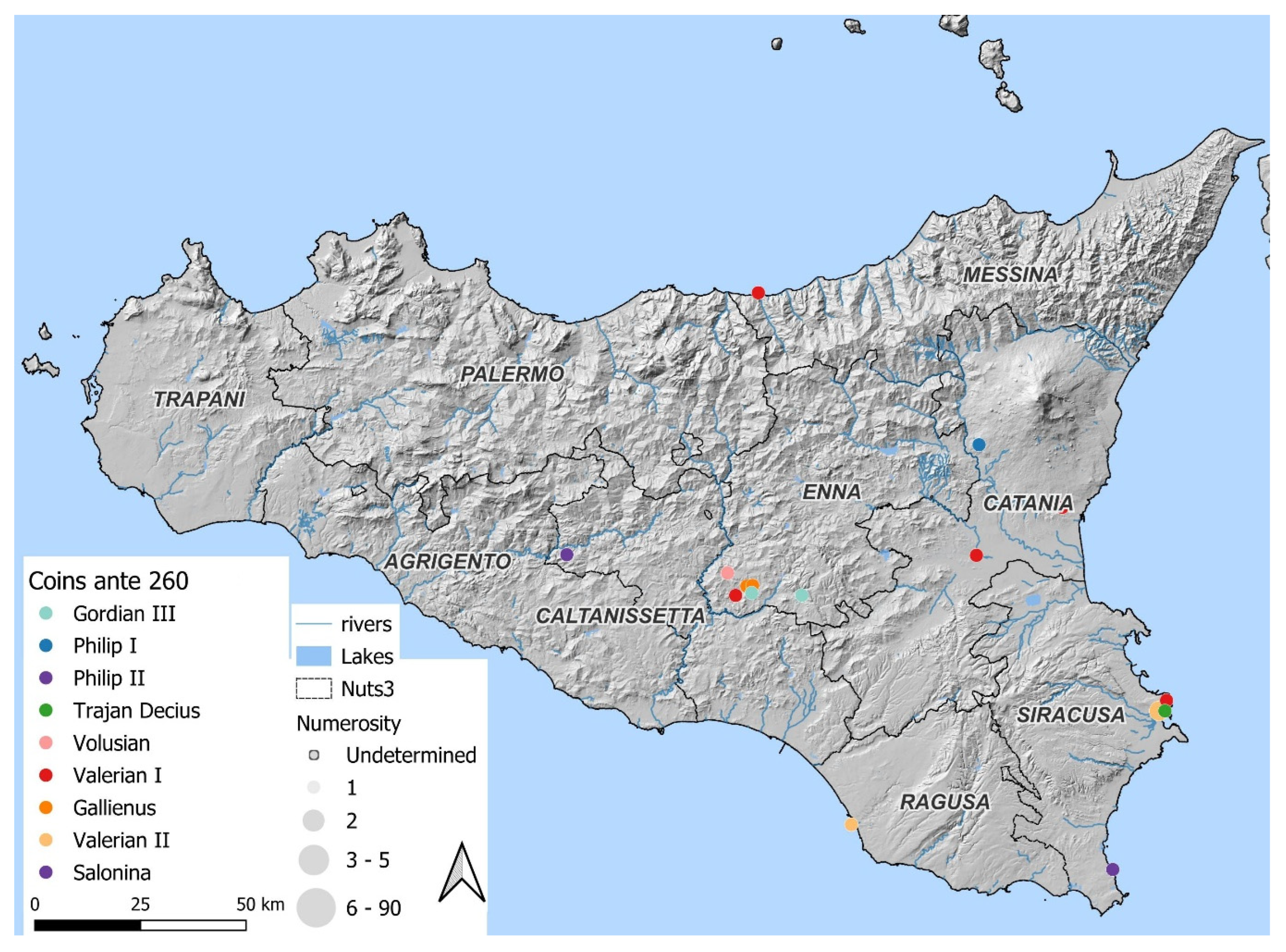

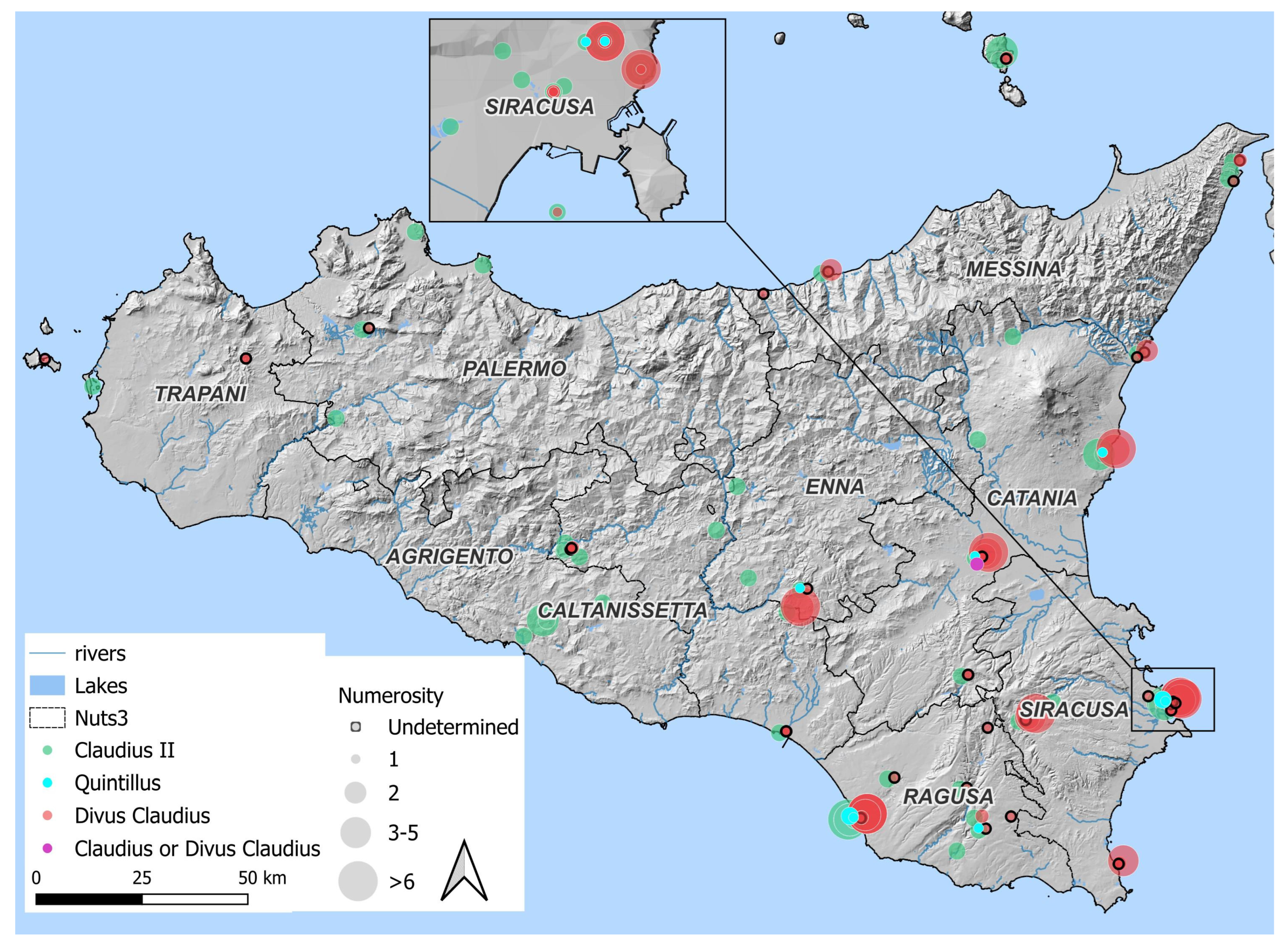
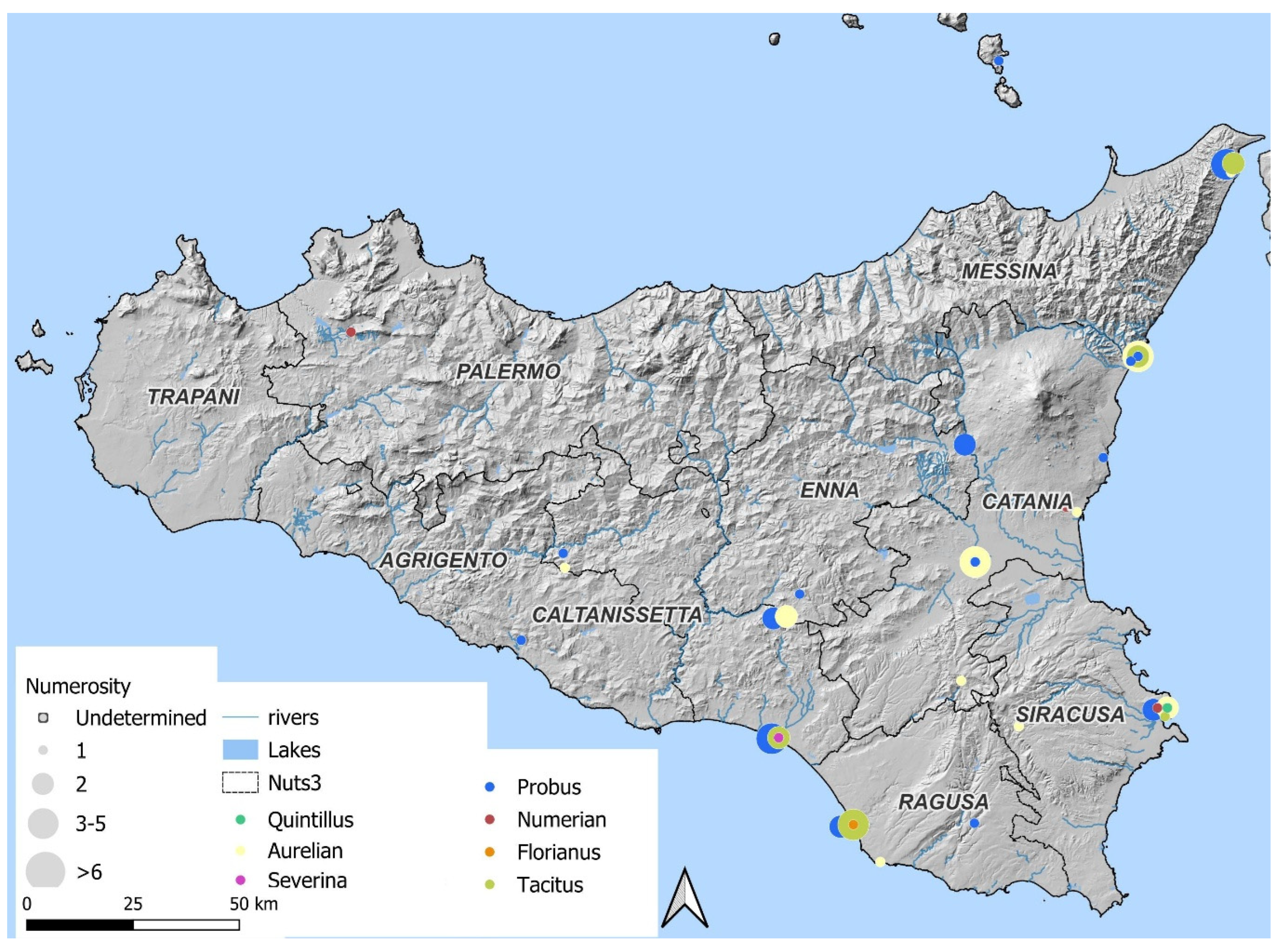

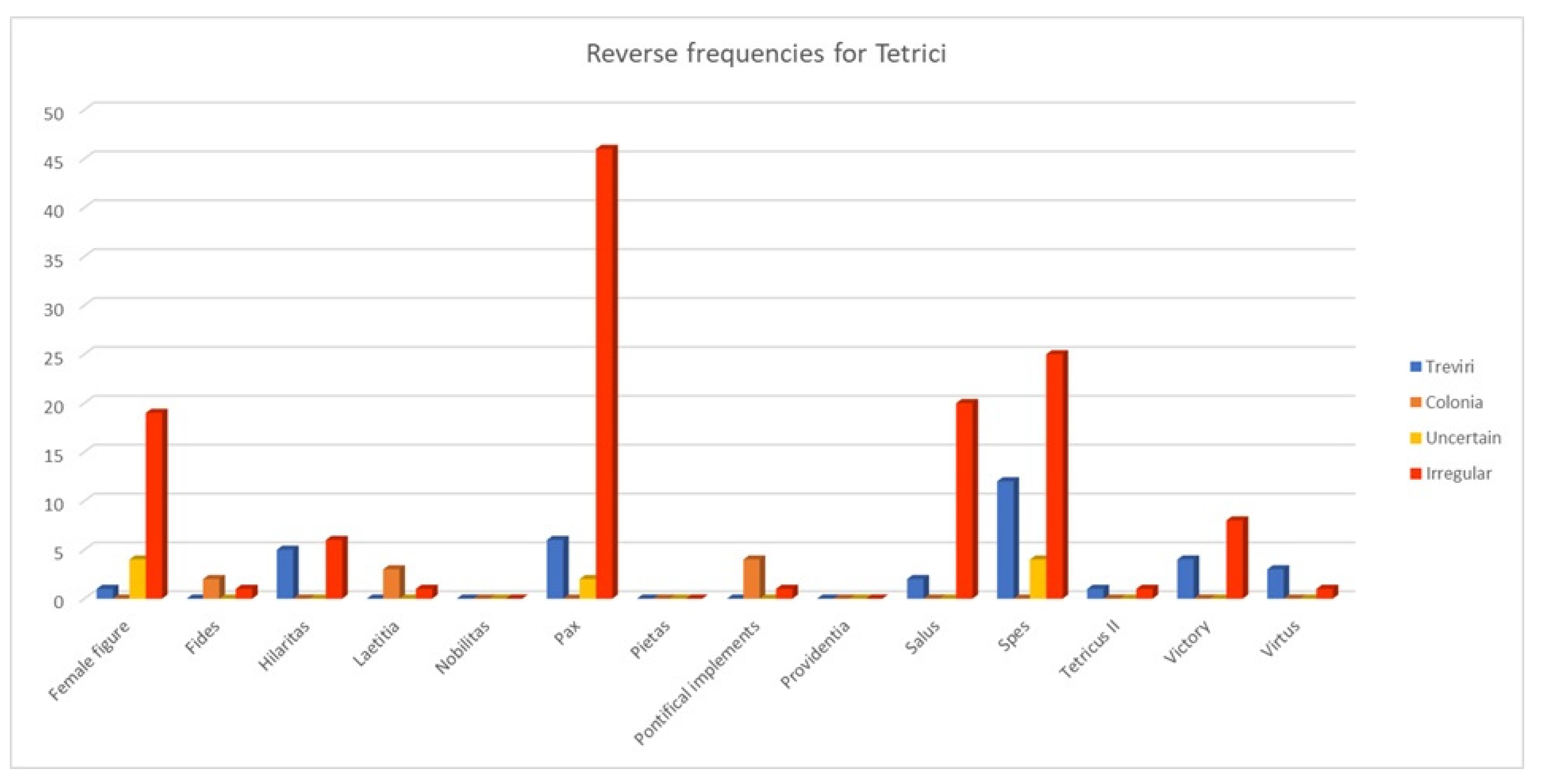
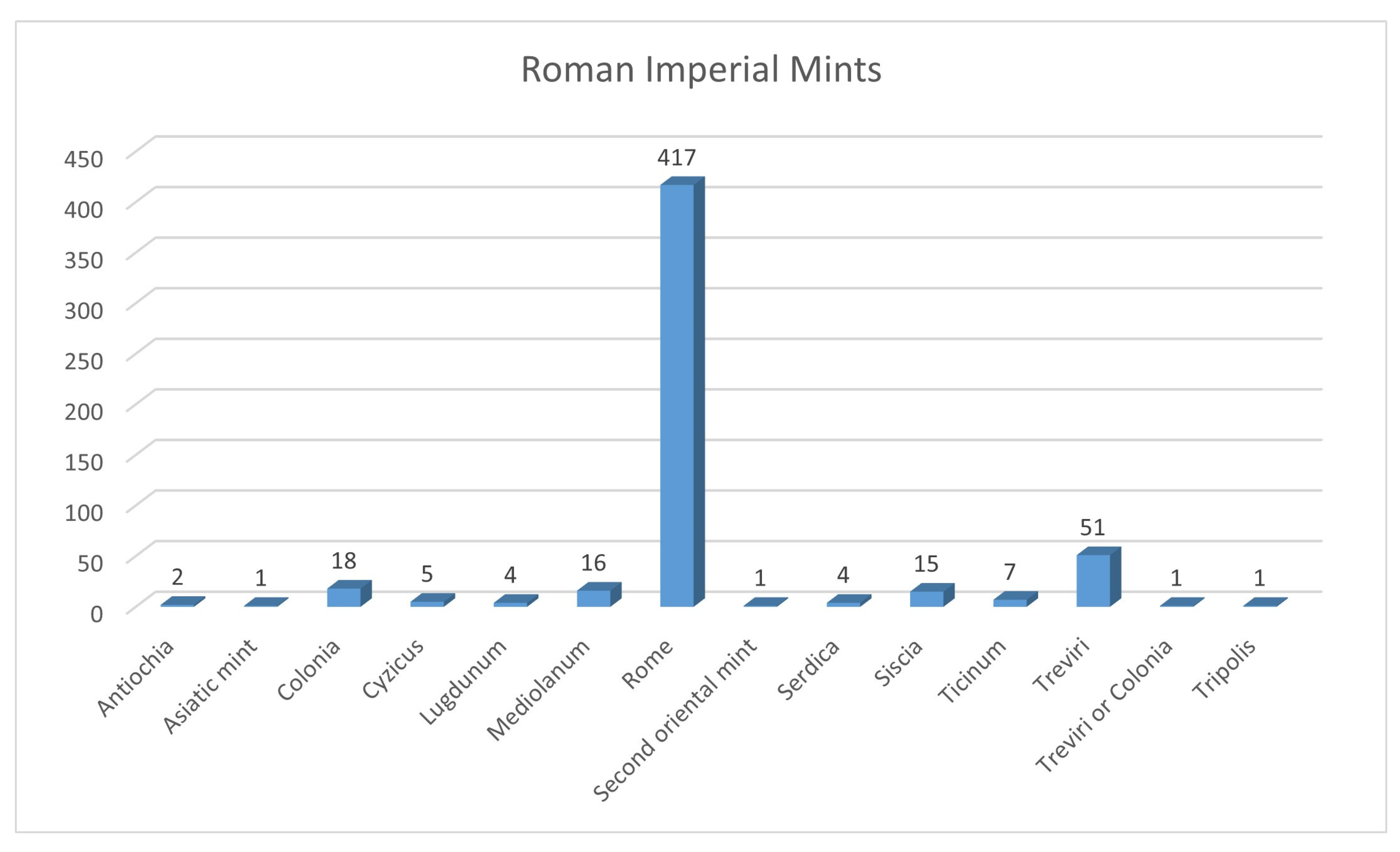
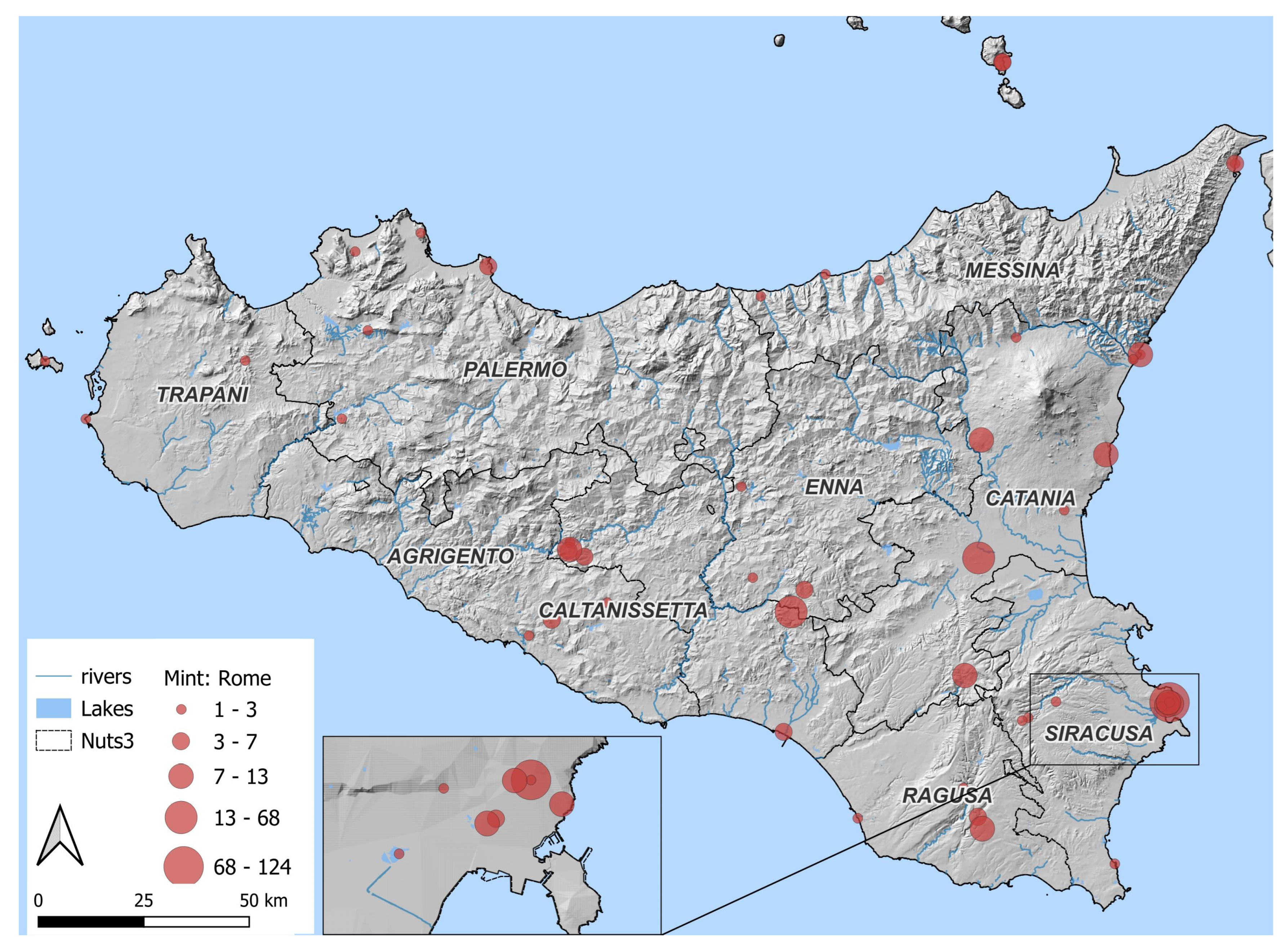

| Field | Description/Vocabulary |
|---|---|
| Id | Identification number |
| x | x coordinates |
| y | y coordinates |
| Finding place | City of finding |
| Province | |
| Toponym | |
| Accuracy |
|
| Finding type |
|
| Numerosity | Number of coins in that location with the same authority, mint and type |
| Obverse | |
| Reverse | |
| Mint | |
| Issue | |
| Minting date | Chronology |
Disclaimer/Publisher’s Note: The statements, opinions and data contained in all publications are solely those of the individual author(s) and contributor(s) and not of MDPI and/or the editor(s). MDPI and/or the editor(s) disclaim responsibility for any injury to people or property resulting from any ideas, methods, instructions or products referred to in the content. |
© 2025 by the authors. Licensee MDPI, Basel, Switzerland. This article is an open access article distributed under the terms and conditions of the Creative Commons Attribution (CC BY) license (https://creativecommons.org/licenses/by/4.0/).
Share and Cite
Vicari Sottosanti, M.A.; Danese, M.; Masini, N. A GIS Approach for Ancient Numismatics: Spatial Analysis of Antoniniani in Sicily (3rd Century AD). Heritage 2025, 8, 222. https://doi.org/10.3390/heritage8060222
Vicari Sottosanti MA, Danese M, Masini N. A GIS Approach for Ancient Numismatics: Spatial Analysis of Antoniniani in Sicily (3rd Century AD). Heritage. 2025; 8(6):222. https://doi.org/10.3390/heritage8060222
Chicago/Turabian StyleVicari Sottosanti, Maria Agata, Maria Danese, and Nicola Masini. 2025. "A GIS Approach for Ancient Numismatics: Spatial Analysis of Antoniniani in Sicily (3rd Century AD)" Heritage 8, no. 6: 222. https://doi.org/10.3390/heritage8060222
APA StyleVicari Sottosanti, M. A., Danese, M., & Masini, N. (2025). A GIS Approach for Ancient Numismatics: Spatial Analysis of Antoniniani in Sicily (3rd Century AD). Heritage, 8(6), 222. https://doi.org/10.3390/heritage8060222








